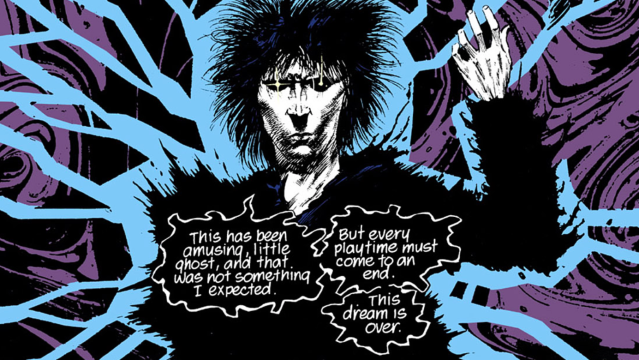In the world of Neil Gaiman’s The Sandman, which is also the world of DC’s core comics continuity, all living things in existence are in some way connected to the Endless, seven anthropomorphic beings who control various facets of reality. As Dream of the Endless is torn out of his realm by humans searching for his sister Death, the universe’s collective unconscious becomes twisted and unstable because, in absence of dreams, it’s much easier for people to succumb to madness.
The Sandman’s script was a quintessential work of Gaiman’s imagination that, when coupled with the illustrations from the dozens of artists who worked over the series’ run, became a fascinating examination of the malleable nature of storytelling and belief. Though The Sandman’s finally on its way to becoming a live-action streaming series after initially being considered for a cinematic adaptation that got stuck in development hell, DC and Audible recently dropped a fully produced audio drama based on the comics and directed by Dirk Maggs. It’s worth giving a listen to because of the novel narrative space it exists within.
Where The Sandman comic pulls you into Gaiman’s vision of the dream lord’s journey across realms, the audio drama instead pushes you to close your eyes and tap into the power of your own dreams in order to fully dive into in the story being told.
As Gaiman’s narration guides you through the story, you’re introduced to James McAvoy’s Dream, Taron Egerton’s John Constantine, Kat Dennings’ Death, and Riz Ahmed’s Corinthian — all of whose voices ring familiar to their characterisations in the comics while also being distinctly foreign because of the drama’s medium. Descriptive as Gaiman’s original prose is and as clearly defined (both visually and thematically) The Sandman’s illustrations were, the audio drama necessitates that you do some of the creative lifting to conceptualize what Dream’s domain might look like were you to have the wherewithal to consider it while in a deep sleep.
The Sandman follows Morpheus — one of Dream’s many names — as he repeatedly slips in and out of his kingdom of dreaming to move through the minds of various mortals and take stock of the Earth throughout history. Dream spends decades trapped on Earth by mostly inept occultists who mistake him for Death in their quest for immortality. He patiently waits as the Dreaming falls to ruin in his absence and he’s left with nothing to do but stew in his seemingly boundless disdain for humanity. While Dream’s forced isolation gives him more than enough reason and opportunity to give in to his inclination of being cold and exacting when dealing with humans, as The Sandman continues, he’s set free. The story begins to show you his more complicated inner workings and his capacity for being every bit as capricious and uncertain as regular people.
Because there’s no visual component to Audible’s take on The Sandman, its presentation of Dream’s tale is markedly more flexible and malleable than the comic, whose aesthetics and tone remain firmly rooted in the comic’s trappings of the late ‘80s and early ‘90s. Though it’s explained that Dream has as many physical manifestations as he does names, there’s a relative static nature to his comics self — a sallow, thin man with a shock of dark hair reminiscent of Gaiman’s own. The audio drama mentions these details in passing, but because you aren’t actually holding a page in your hands of a deathly looking man staring up at you, there’s a way that this production — and it truly is a production in the truest sense of the word — of The Sandman lends itself to a sort of reinterpretation unique to anyone who listens to it.
Because the project has a full cast of actors, and since each scene is meticulously crafted to make you feel as if you’re overhearing conversations you aren’t meant to be privy to, it all has the interesting effect of putting a healthy amount of distance between you and the narrator. Because this adaptation of The Sandman is so faithful to the original books, every bit of Gaiman’s narrative sensibilities are quite intact. That goes for the good, like the poetic way he describes Dream’s relationship with his siblings, and the bad, like how the story frequently features women, nonbinary, and queer people being sexually menaced or outright assaulted by deranged, violent men.
Even though audio dramas are an older form of media, right now it isn’t clear how and when storytellers are going to be able to get back into regularly weaving dreams into films and television. So The Sandman, in particular, offers up the sort of immersive escapes into fantasy that people have been searching for during the covid-19 pandemic. The Sandman is not simply a one-to-one translation of a beloved comic, but rather, it’s an invitation to step into a Dreaming of one’s own, both to take a break from reality and muse about how the world might reshape itself in your brief absence.
